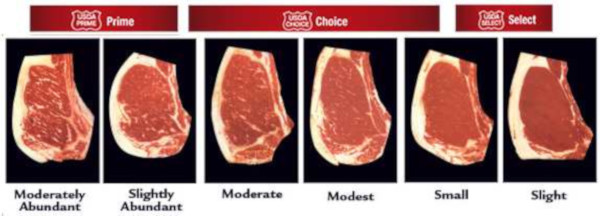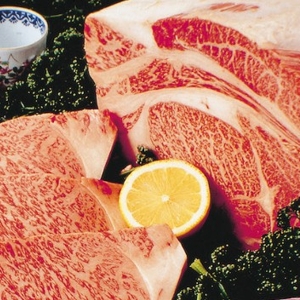I often talk about Marbling when discussing how to choose and prepare Red Meats. And often the people I’m talking to get a blank look on their faces until I explain what Marbling is and why it’s a good thing. Even then, some folks question the healthiness of Marbling in our ‘lean’ culture…
 The USDA Official Beef Grading Scale
The USDA Official Beef Grading Scale
Based on the abundance of Marbelling…
What is Marbling?
Marbling is simply the pattern of fat veins in the muscle tissue of Red Meats (mainly Beef). It looks like the veins of contrasting colours that wander through the Marble that we use for floors, walls and, yes, counter tops.
What does it do?
Marbling Fat breaks down (renders out) during cooking making the Meat more tender and flavourful. It’s as simple as that.
How do I gauge Marbling?
Thank goodness for clear plastic food film. Before ‘Saran’ wrap, Meat was typically wrapped in brown paper with one side varnished to make it more or less liquid-proof. Fortunately, you got to choose your Meat before it was wrapped. But with the decline in Butcher shops and the rise in supermarkets, something had to give. Anyway, plastic film is more liquid-proof than paper and lets you closely inspect at least one side of a cut of Beef before committing to buy it.
You can clearly see and assess the Marbling in your meat through plastic and make confident buying decisions. Use the chart reproduced above to guide your evaluations.
What am I looking for?
Heavier Marbling is considered better than light or no Marbling. That’s why you’ll find that higher grades of Meat have more Marbling. They’re going to be more tender and juicy when cooked (see chart above). You also want your fat veins to be fine-textured. Large deposits of Fat in the muscle won’t tenderize like a multitude of fine, evenly distributed veins.
It seems counter intuitive that more Fat would be better, but Marbling Fat renders out when cooking. You don’t actually eat all that much of it, especially if you grill your Steaks or cook your Roasts on a wire rack, both techniques which direct excess liquid fat away from the Meat. Unless, that is, you’ve cashed in the kids’ college fund and bought a Waygu steak, arguably the most exclusive, and definitely the most expensive type of Beef in the world, which is 50 percent or more Marbling Fat (see image at top of page).
As a simple guide, I recommend that Steak Lovers opt for well-Marbled Ribeye or Striploin Steaks at least 1 in. / 2.5 cm thick. One side note: these are boneless cuts, so you’re not paying for something you’d just throw away.
Why do I pay more?
Basically, you pay more for higher-grade, better-Marbled Meat because it’s more desirable. Seems counter intuitive, doesn’t it, when you consider how much more you pay for ‘Extra Lean’ Ground Beef compared to ‘Lean’, ‘Medium’ or ‘Regular’? Again, with the Ground Beef, less Fat is more desirable, so you pay more for the ‘Lean’ product.
How do I cook well-Marbled Meat?
I prefer to cook a well-Marbled Steak quickly, either on a Grill or a Grill Pan. But the fat that makes good Meat tender and flavourful also makes it harder to overcook than than leaner cuts. Nevertheless, you can still ruin a nicely-marbled piece of Beef by cooking it too long, until it gets dry and tough. The well-distributed Fat in a well-marbled piece of Meat can also make for better searing.
Just in case you were wondering (and I’ve covered this point before), seating meat doesn’t help it hold in its juices. That’s a myth. What it does is create a layer of brown caramelized flavour on the Steak. For Roasts, the layer of flavour is why you want to conserve the drippings to make great-tasting Gravy.
Can I ‘help’ a less-Marbled cut?
Why do you think Pro Chefs always wrap a Filet Mignon in a strip of Fatty Bacon? The Filet is potentially very tender and flavourful, but it has little Marbling of its own. Wrapping a cut of Meat in Fat is known as ‘Barding’. Some thicker cuts get what’s known as the ‘Larding’ treatment, in which a big needle is used to ‘thread’ long, thin strips of Fat through the middle of the Meat, mimicking Marbling. You can get a Larding Needle at any good cookware store. All it takes to Bard a steak is a strip of bacon and a couple of sturdy, toothpicks.
Now you know…
There’s no reason for you ever to produce another tough Steak, Chop or Roast again!
~ Maggie J.

